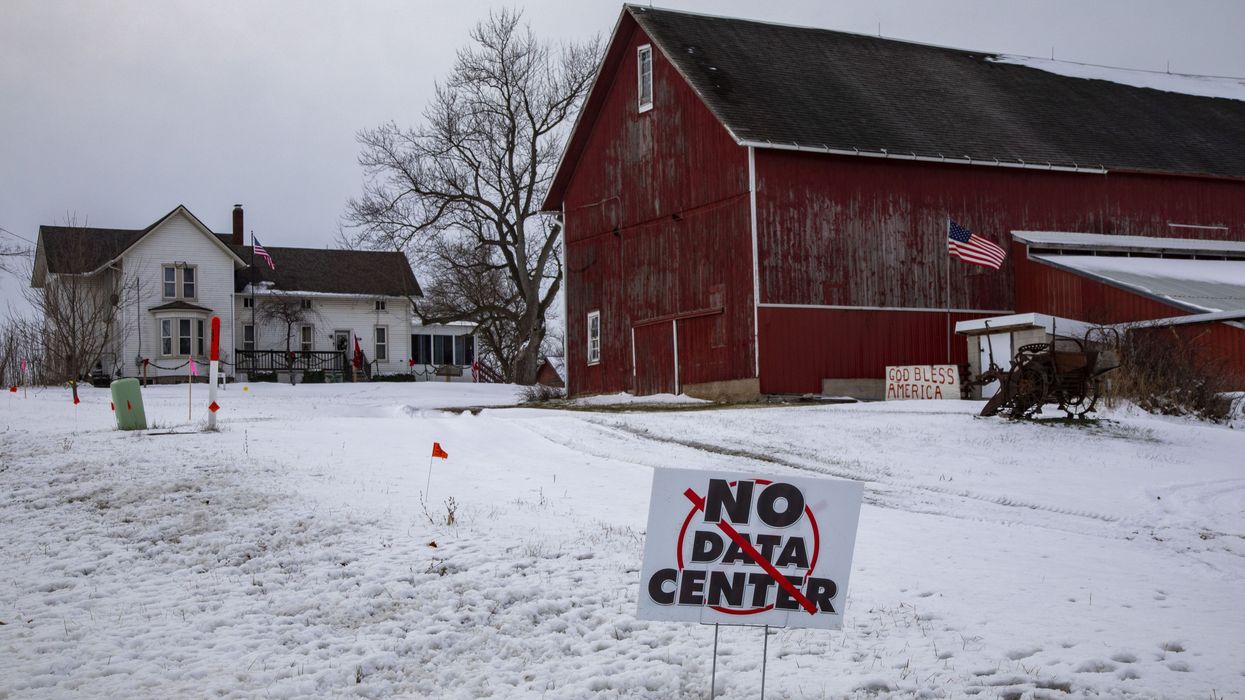November, 24 2008, 03:00pm EDT

For Immediate Release
Contact:
Wade Willis, Defenders of Wildlife, (907) 276-9453
Nineteen Alaskan Wolves Already Killed This Season
The Alaska Department of
Fish and Game reports that as of today at least 19 wolves have been killed by
aerial hunters since the first wolf was shot on October 28, a number greater
than all the wolves killed in November last year. The reported kills have all
occurred in the Upper Yukon-Tanana predator control area.
"The season is off to a
disturbing start," said Wade Willis, Alaska representative for Defenders of Wildlife.
JUNEAU, Alaska
The Alaska Department of
Fish and Game reports that as of today at least 19 wolves have been killed by
aerial hunters since the first wolf was shot on October 28, a number greater
than all the wolves killed in November last year. The reported kills have all
occurred in the Upper Yukon-Tanana predator control area.
"The season is off to a
disturbing start," said Wade Willis, Alaska representative for Defenders of Wildlife. "For years,
the department has been setting wolf removal targets based on largely anecdotal
information and placing the balance of prey and predators in
jeopardy."
The aerial gunning season opens
each year after Fish and Game officials complete an annual survey of moose
populations in predator control units.
Defenders has asked Fish and
Game for this year's wolf target numbers, but has not received the information.
In the prior years, the Fish and Game has set goals to eliminate as many as 300
wolves in this area. Hundreds more are targeted in the other designated predator
control areas.
For the past five winters, Fish
and Game has issued aerial hunting permits to private citizens for five control
areas. Aimed at reducing wolf and bear populations that compete with hunters for
moose and caribou, the purported goal of predator control is to benefit rural
subsistence hunters by attempting to keep big game populations high. Yet the
state conducts many of its predator control programs in regions where resident
subsistence hunters have to compete with out of state trophy hunters for big
game.
Conservation groups, including
Defenders of Wildlife, contend that wolves are being used as the scapegoat for
low moose and caribou populations - pointing out that the Fish and Game is not
addressing other factors that are impacting the herd, such as climate change,
which could affect the area's carrying capacity. In addition, basic scientific
standards are not being met, such as collecting accurate population surveys,
especially for predators and even for the big game species.
According to the
Alaska chapter of The Wildlife Society, a local branch of
wildlife biologists, the problems facing the state's predator control program
stem from Alaska's 1994 Intensive Management Law.
In a policy statement, The
Wildlife Society criticized the law for placing too great an emphasis on
predator control, stating that the legislation behind today's predator control
programs is "counterproductive to sound wildlife management...will result in
needless and undesirable deterioration of Alaskan wildlife populations,
including both predator and prey species."
"Aerial predator control
programs have been conducted for five years. It's time for the department to
conduct an honest review of these programs," Willis said. "Instead of using
science, the Board of Game is gambling with the long term health of
Alaska's wildlife resources, basing its decisions on opinion
and anecdotal information."
Learn more about what Defenders is doing to help wolves in Alaska.
Defenders of Wildlife is the premier U.S.-based national conservation organization dedicated to the protection and restoration of imperiled species and their habitats in North America.
(917) 363-4149LATEST NEWS
‘Feckless’ Ken Martin Rebuked Over DNC Decision to Bury Autopsy of 2024 Election Disaster
"You can’t run as the party of democracy and transparency and then stick your own election autopsy in a drawer," said one critic.
Dec 18, 2025
The Democratic National Committee on Thursday drew strong criticism when it was revealed that the party's autopsy of its failures in the 2024 presidential election would not be publicly released.
According to the New York Times, DNC Chairman Ken Martin has decided against releasing the report because he "believes that looking back so publicly and painfully at the past would prove counterproductive for the party as it tries next year to take back power in Congress."
The decision to keep a lid on the report, however, is already sparking a backlash.
The New Republic's Greg Sargent argued in a Thursday piece that the decision by the DNC to bury the report "should unleash harsh criticism and recriminations" because it "could end up protecting key actors inside the party from accountability over the blown but winnable contest."
Sargent then pointed the finger at Future Forward, a super PAC that he said has earned a reputation for blowing large sums of money on ineffective television ads.
"Well before Election Day, the PAC came under harsh criticism from some Democrats who argued that it hadn’t spent sufficient money earlier in the campaign on ads attacking Trump," Sargent wrote. "Other Democrats charged that Future Forward’s ad-testing model and addiction to traditional TV ads led to anodyne communications and that its flawed theory of politics caused it to refrain from sufficiently targeting Trump, letting him avoid blame for his first-term disasters on Covid-19 and the economy."
Jeff Hauser, founder and executive director of the Revolving Door Project, told Common Dreams that Martin's decision to bury the report was part of a broader pattern of a lack of accountability for US elites, an issue that he said is becoming more important" as America gets less and less equal."
"Ken Martin seems determined to become the Merrick Garland of DNC Chairs," added Hauser, "a feckless amiable sort unwilling to take on the powerful people who scream out for stringent accountability. Democrats ought to re-center their entire party around holding elites, be they from Big Tech, the Democratic Party establishment, Big Oil, or Trump's kleptocratic regime, accountable."
Rotimi Adeoye, a columnist for MS Now and former communications strategist for the American Civil Liberties Union, also accused party insiders of trying to protect elites at the expense of rebuilding public trust with voters.
"This is also happening as Congressional Dems sit at a -55 net approval," he argued on X. "If your numbers are that bad and your response is to bury the autopsy, you’re basically telling voters the insiders get protection while the base gets lectures."
Adeoye added that "you can’t run as the party of democracy and transparency and then stick your own election autopsy in a drawer," and said that "if the DNC thinks the report would 'hurt the party,' that means the problems are real and political, not analytical—and that’s exactly why people want to read it."
Journalist Yashar Ali, meanwhile, sent out a message on Bluesky encouraging DNC staffers who have access to the report to let him publish it.
"If you have access to this DNC report, please send it to me," he wrote. "I will protect your anonymity."
While the DNC isn't releasing its own report documenting party failures in 2024, the progressive advocacy group RootsAction last week published an autopsy written by journalist Christopher D. Cook, who argued that former Vice President Kamala Harris' campaign made a major mistake by trying to court so-called moderate Republican voters and corporate donors instead of focusing on the struggles of working-class Americans.
"This was a preventable disaster," Cook said, "but Harris and the Democratic Party leadership prioritized the agendas of corporate donors and gambled on a centrist path, while largely abandoning working-class, young, and progressive voters."
Keep ReadingShow Less
'It's All About the Oil,' Says Venezuelan Defense Minister After 'Incoherent' Trump Claims
The minister also echoed Venezuelan President Nicolás Maduro's declaration that the US seizing oil tankers is "piracy."
Dec 18, 2025
As President Donald Trump continues his march toward a US war on Venezuela, the South American country's defense minister on Wednesday blasted his "delusional" and "completely incoherent" claims, and echoed warnings from around the world that "it's all about the oil."
In addition to killing nearly 100 people by bombing alleged drug smuggling boats, Trump has authorized covert Central Intelligence Agency action in Venezuela and repeatedly threatened attacks on land. Late Tuesday, Trump declared a naval blockade that he said will continue until the nation returns to the US "all of the Oil, Land, and other Assets that they previously stole from us."
Trump appears to be referring to the presence that US companies had in Venezuela before the country nationalized its oil industry in the 1970s. On Wednesday, the Republican president told reporters: "Getting land, oil rights, whatever we had—they took it away because we had a president that maybe wasn't watching. But they're not gonna do that. We want it back. They took our oil rights. We had a lot of oil there. As you know, they threw our companies out, and we want it back."
In a Wednesday speech, Venezuela's defense minister, Vladimir Padrino López, pushed back against Trump's blockade, threats of military action, and "delirious" claims that the country stole its own oil, land, and other assets from the United States. The minister also reiterated a declaration from Venezuelan President Nicolás Maduro that the US seizing oil tankers is "piracy."
As CNN reported, Maduro—whom Trump aims to oust from power—gave a similar speech about the US administration's purported goal of combating drug trafficking in Caracas on Wednesday.
"It is simply a warmongering and colonialist pretense, and we have said so many times, and now everyone sees the truth. The truth has been revealed," Maduro said. "The aim in Venezuela is a regime change to impose a puppet government that wouldn't last 47 hours, that would hand over the Constitution, sovereignty, and all the wealth, turning Venezuela into a colony. It will simply never happen."
According to Anadolu Agency, Venezuelan Vice President Delcy Rodríguez said on social media this week: "We will continue to be free and independent in our energy relations. Together with President Nicolás Maduro, we will continue to defend the homeland.”
Although the Republican-controlled US House of Representatives on Wednesday night narrowly defeated a pair of war powers resolutions aimed at reining in Trump's actions toward Venezuela, lawmakers from both major parties have also called out the administration's drug claims and argued against launching another US war for oil.
Responding to a clip of Trump's comments to reporters on Wednesday, US Rep. Gregory Meeks (D-NY), who sponsored one of the resolutions, wrote on social media: "I've said it many times before: This is not about drugs. If the goal were stopping narcotics, this administration would not be talking about oil rights or seizing tankers. That is not a lawful basis for war."
Rep. Thomas Massie (R-Ky.), one of the few Republicans who supported the resolutions, took to the House floor ahead of the votes on Wednesday to denounce Trump's march toward an unconstitutional war and declare that "this is about oil and regime change."
Keep ReadingShow Less
Big Tech Ramps Up Propaganda Blitz As AI Data Centers Become Toxic With Voters
One Michigan state legislator said data centers are emblematic of the divide between "tech billionaires who are seizing power and… the working and middle classes."
Dec 18, 2025
As voters across the country begin to rally against the unchecked construction of data centers, artificial intelligence companies are panicking and investing millions into propaganda to paint the energy-sucking facilities in a more positive light.
By 2030, the amount of energy demanded by US data centers is expected to more than double, according to the International Energy Agency.
Energy costs have spiked considerably in the states with the most data centers. And as the industry continues its breakneck expansion, one watchdog report found that consumers on America's largest electric grid are expected to pay hundreds of dollars more to meet increased power demand from now until 2027.
These costs became an unexpected point of emphasis for Democrats in November, whose calls for greater transparency from tech companies seeking to build data centers propelled them to victory in elections from New Jersey to Virginia.
But tech companies want to keep building, and as AI threatens to become a central villain of the 2026 midterm elections, Politico reports that companies are putting the wheels in motion to portray themselves "as job creators and economic drivers rather than resource-hungry land hogs."
As Gabby Miller wrote on Wednesday:
A new AI trade group is distributing talking points to members of Congress and organizing local data center field trips to better pitch voters on their value. Another trade association, the Data Center Coalition, nearly tripled its lobbying spend in the third quarter of this year from the previous quarter, according to US lobbying disclosures.
The social media giant Meta, with billions invested in its own fleet of data centers from Stanton Springs, Georgia, to Richland Parish, Louisiana, has been running a multimillion-dollar ad campaign depicting data centers as a boon to agricultural towns in Iowa and New Mexico. It has spent at least $5 million nationally in the past month on TV ads plugging Meta’s $600 billion pledged investment in tech infrastructure and jobs.“
"There’s a very bad connotation around data centers. And this is something that, frankly, the data center industry needs to figure out,” said Caleb Max, president and CEO of the National Artificial Intelligence Association, a new trade group established in January to accelerate AI infrastructure development.
Tech giants are also putting focus on swaying policymakers. Max told Politico that his group has been making the rounds to talk with elected officials in critical battlegrounds for the AI future, like Georgia, Ohio, and Texas, to craft a "positive pro-data center campaign message for elected officials, for businesses, for current lawmakers who are going to be up for reelection in 2026."
Meanwhile, Meta reportedly aired its 30-second TV spots "featuring small-town imagery of farming equipment and mom-and-pop diners" in Washington, DC, and nine state capitals. Miller says this suggests "that policymakers might be Meta’s real target audience, rather than the rural Americans impacted by these energy-hungry server hubs."
AI and tech firms plan to ramp up the lobbying and ad blitzes as the next election draws nearer, and their attempt to reframe the narrative about data centers comes as no surprise, as communities across the US in recent months have increasingly come out in force to push their representatives to halt the construction of the facilities.
In Saline Township, a small community just outside Ann Arbor, Michigan, more than 800 residents descended upon a public input session earlier this month to protest against the construction of a $7 billion center—predicted to consume as much energy as the entire city of Detroit—fearing it would raise energy costs, pollute groundwater, and force the state to abandon its nation-leading climate policies.
The town initially blocked the plans, but reversed course following a lawsuit from a real-estate billionaire closely aligned with President Donald Trump, whose administration has backed the $500 billion "Stargate" initiative by OpenAI, SoftBank, and Oracle to expand data centers.
On Tuesday, Michigan Attorney General Dana Nessel joined Saline residents at a gathering outside the state Capitol, where they called for a statewide moratorium on data centers.
Data center projects have run into similar resistance nationwide. As of March, the group Data Center Watch found that more than $64 billion worth of projects had been blocked or delayed due to local opposition since May 2024. This opposition has reached a fever pitch in recent months.
Last week, after it received hundreds of angry comments from residents, the city council of Chandler, Arizona, unanimously rejected plans for a $2.5 billion data center that had been pushed by former US Sen.-turned lobbyist Kyrsten Sinema (D-Ariz.).
Even in Trump country, backlash has been fierce. Last week, the planning commission of Starke County, Indiana, voted unanimously to recommend a one-year moratorium on the construction of centers bigger than 5,000 square feet after residents flooded a meeting to raise concerns about water pollution and energy costs.
"In Memphis, Tennessee, Elon Musk's AI company has built a data center whose energy demands have outgrown the region's energy capabilities," said one resident, Sophia Parker. "We've heard from everyone else saying that our infrastructure does not have the capacity to support a data center. And as a result, gas turbines are emitting nitrogen oxide to the point where residents cannot breathe. Their community is being used as a sacrifice for others to get rich. We cannot allow that to happen to us."
Last month in Montour County, Pennsylvania—a state where electric prices have surged by 15% this year, double the national average—environmentalists formed an uncommon alliance with conservative farmers and the Amish to stop the county planning commission from rezoning 1,300 acres of agricultural land for a massive new center.
“Stay out. We wouldn’t even be having this conversation without federal involvement,” said Craig High, a 39-year-old Trump supporter quoted by Reuters. “Both parties are pushing data centers and giving regulatory relief—water permits, permitting, all of it.”
“This is part of an experience that America and the world is having around tech billionaires who are seizing power and widening the gap between those who have much too much… and the working and middle classes,” Yousef Rabhi, a former Democratic state legislative leader from Michigan and clean energy advocate who opposes the construction of data centers, told The Guardian. “That’s what these data centers are symbolic of, and they’re the vehicle for the furtherance of this divide."
Keep ReadingShow Less
Most Popular


